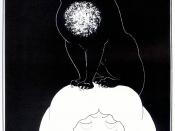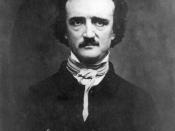Edgar Allan Poe uses elaborate diction to take the reader into the mind of a psychotic murderer in "The Black Cat"ÃÂ. By intensively describing the motives and desires behind the narrator's actions, Poe constantly shocks and disgusts the reader. This "killer's confession"ÃÂ (Peeples 147) shows a seemingly calm and intelligent man justifying murder with excuses of alcohol while the reader realizes a twisted connected between his relationship with his black cat and his wife. Poe's chilling narrative style also creates an eerie atmosphere throughout the story. Combined with the terrifying events the narrator adds a spine tingling effect to the delivery of the tale.
As the story begins, a very normal and calm narrator speaks of his life, "a series of household events"ÃÂ (Poe 96). He describes his wife, pets and his cat, a "beautiful animal"ÃÂ (Poe 96). However, as he begins to tell about the terrifying events, which are anything but typical, his diction and style change, once long flowing sentences are now choppy with many pauses and shifts.
As Scott Peeples perceptively observes, "Poe toyed with the instability of language and meaning"ÃÂ (Peeples ix). These slight transitions set a new atmosphere in the mental picture of the reader.
When the first acts of violence are made, the narrator is intoxicated and therefore blames alcohol for his rage. However, the reader is skeptical to believe that alcohol could cause such extreme acts, such as a man seizing a frightened cat and cutting its eye out. The narrator explains that the link between his alcohol abuse and his rage is a "disease"ÃÂ (Poe 97) and his actions are "gin-nurtured"ÃÂ (Poe 97). Peeples states that the narrator's defense is "built on lame excuses"ÃÂ (Peeples 96). This clever man is simply "shifting responsibility from himself to his illness"ÃÂ (Peeples 96).


